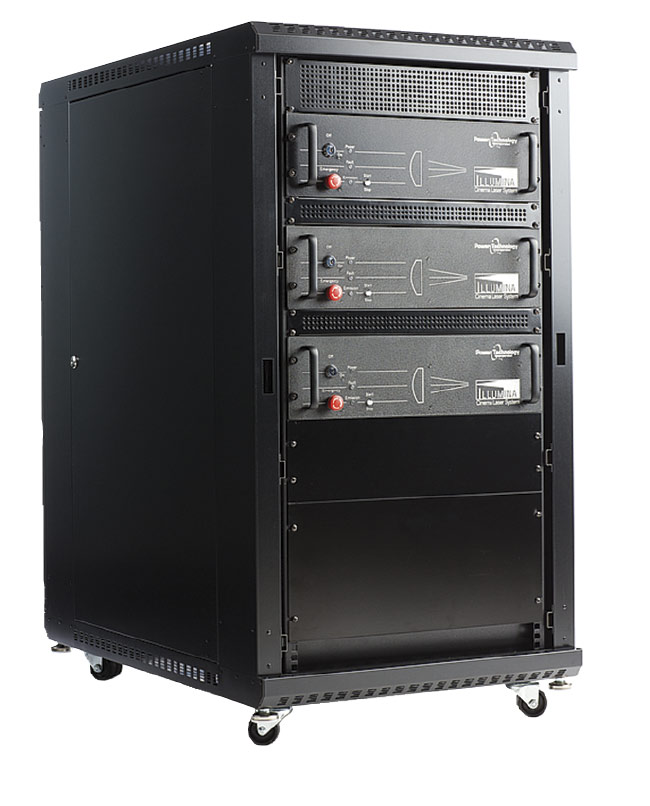Full company details
Power Technology Inc.
 16302 Alexander Rd.
16302 Alexander Rd.
Alexander, AR 72002
United States
Phone: +1 501-407-0712
Fax: +1 501-407-0036
Solutions for Laser-Based Cinema Projection
Photonics Spectra
Dec 2019Before purchasing laser-based projectors, cinema owners should know there are alternatives.WALTER BURGESS, POWER TECHNOLOGY INC.
When companies present laser-based cinema projector solutions on their websites or in their literature, they tend
to promote complete projector systems. This leaves website visitors with the
mistaken impression that they must purchase an entirely new projector — including a complicated and expensive light-processing engine — to receive the benefits of laser projection.
While it’s true that laser technology has replaced xenon lamps in most new cinema projectors, several companies have introduced laser light-based upgrades that improve picture quality and reduce the cost of operating large projectors. The upgrades enable these bulb-based projectors to achieve superior performance without the expense of an entirely new laser-based projector. Upgrades allow projector owners to extend the useful life of existing projectors while saving tens of thousands of dollars in the process.
New laser technologies
New laser-based cinema projectors are based on two types of laser technologies, laser phosphor and RGB laser designs. Therefore, it makes sense that upgrade solutions also use these technologies. Laser phosphor technology creates white light by shining blue GaN (gallium nitride) semiconductor laser diodes onto a phosphor. This phosphor technique creates the required number of lumens with a fraction of the electricity required by xenon bulbs. Since the phosphor does not create a perfect D65 white light, additional LEDs or lasers can be added to the phosphor’s emission to achieve an acceptable white balance. Undesirable colors created by the phosphor emission are reduced or eliminated by installing optical filters.
Direct RGB laser technology is widely considered to produce a superior image quality. The color gamut produced by RGB lasers is vastly superior to the less expensive phosphor technology. As an upgrade technology, the RGB laser technique uses the emissions from discrete red, green, and blue lasers to make a perfect white balance. Unlike the phosphor technique, no additional filters are needed to achieve the desired white balance. It is relatively simple to vary the intensity of any component color to achieve the perfect D65 white color.

A laser upgrade for a cinema projector. Courtesy of Power Technology Inc.
Laser phosphor upgrades are available for most common cinema projectors. Projector manufacturer Barco, for example, offers laser phosphor-based upgrades for many of its older bulb-based projectors. Other third-party companies such as Power Technology Inc. and Cinemeccanica offer an RGB laser upgrade that is compatible with the four most popular brands of cinema projectors, while other companies such as Appotronics Inc. manufacture a variety of phosphor-based upgrades for popular brands of projectors.
Resolving misperceptions
Despite popular belief, RGB laser projectors and projector upgrades are not composed of a single large laser for each red, green, or blue color. Early attempts at laser projection did use larger lasers for a single color, but the market quickly learned that large lasers were not a cost-effective solution. Eventually, a better solution using large quantities of smaller, mass-produced lasers was designed. Today’s modern cinema projector (or projector upgrade) contains hundreds of smaller lasers. The smallest of these lasers may be 1 W per emitter. At this power level, it takes hundreds of emitters to illuminate a cinema screen to the required brightness.
Combining hundreds of laser beams is not a trivial task. But, manufacturers of projectors and projector upgrades have mastered the art of combining multiple beams using the most cost-effective technology. While there are many ways to combine laser beams, not many are cost-effective enough to compete in the cinema industry.
Return on investment
Most cinema chains are looking for a rapid return on their investment, and the need for a cost-effective laser solution cannot be overlooked. The xenon lamps used in bulb-based cinema projectors cost between $800 and $2000 each. They also have a relatively short lifetime of approximately 1000 hours and draw 4 to 6 kW depending on screen size and brightness. Even with the large overhead cost of running xenon lamps, a laser-based light source will still need to be extremely cost-effective.
Additionally, not every red, green, or blue laser has the required lifetime necessary for cinema projection. Most laser upgrades and new projectors are rated for 30,000 hours. However, very few commercially available visible lasers are compatible with this lifetime demand.
While purchasing a new laser projector will certainly deliver great images on screen, theater owners have the choice to upgrade instead of buying new equipment, and they should explore all their options. Upgrading an entire multiplex or a single screen could yield substantial savings when compared to buying new projectors.
Meet the author
Walter Burgess is the vice president of sales and engineering at Power Technology Inc. and is passionate about lasers, optics, photonics, and entrepreneurship. He provides technology leadership, project management, and business leadership to a great team of people who
manufacture lasers for cinema display
(projection), life science, analytic, defense,
scientific, and semiconductor applications.